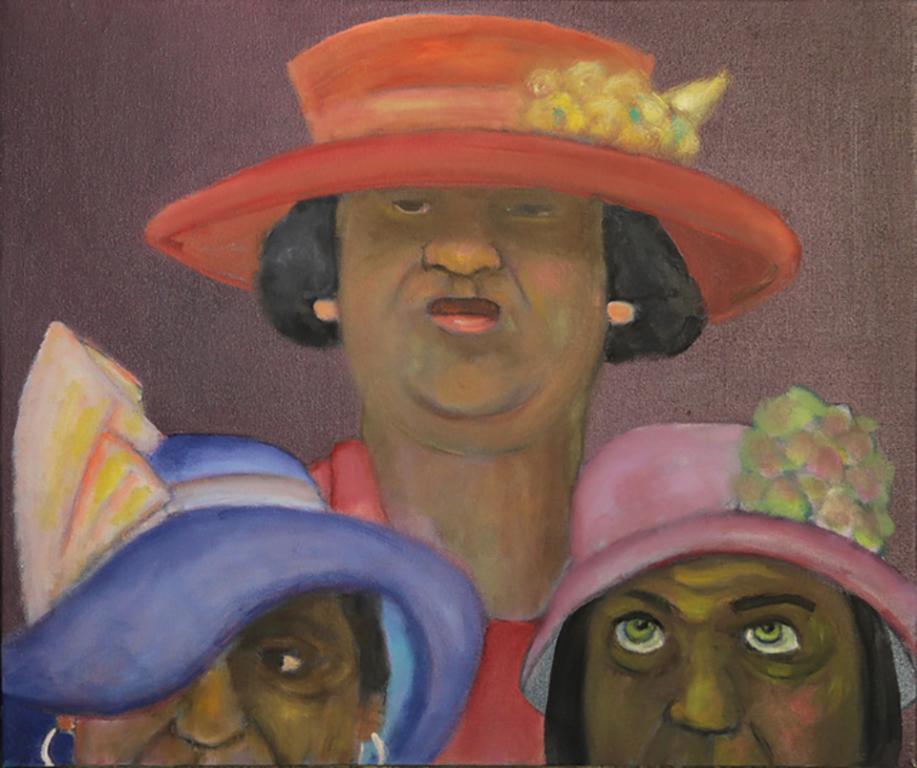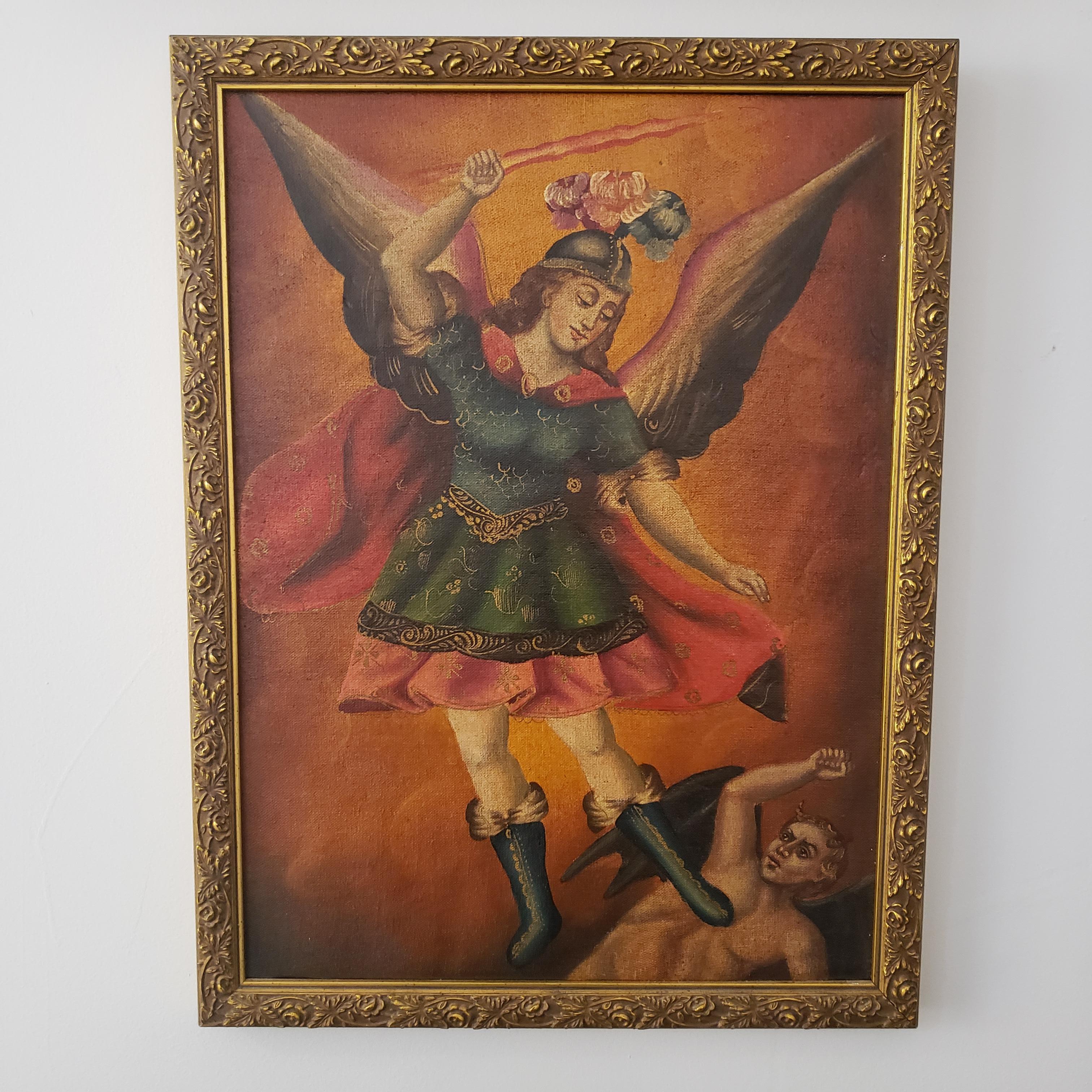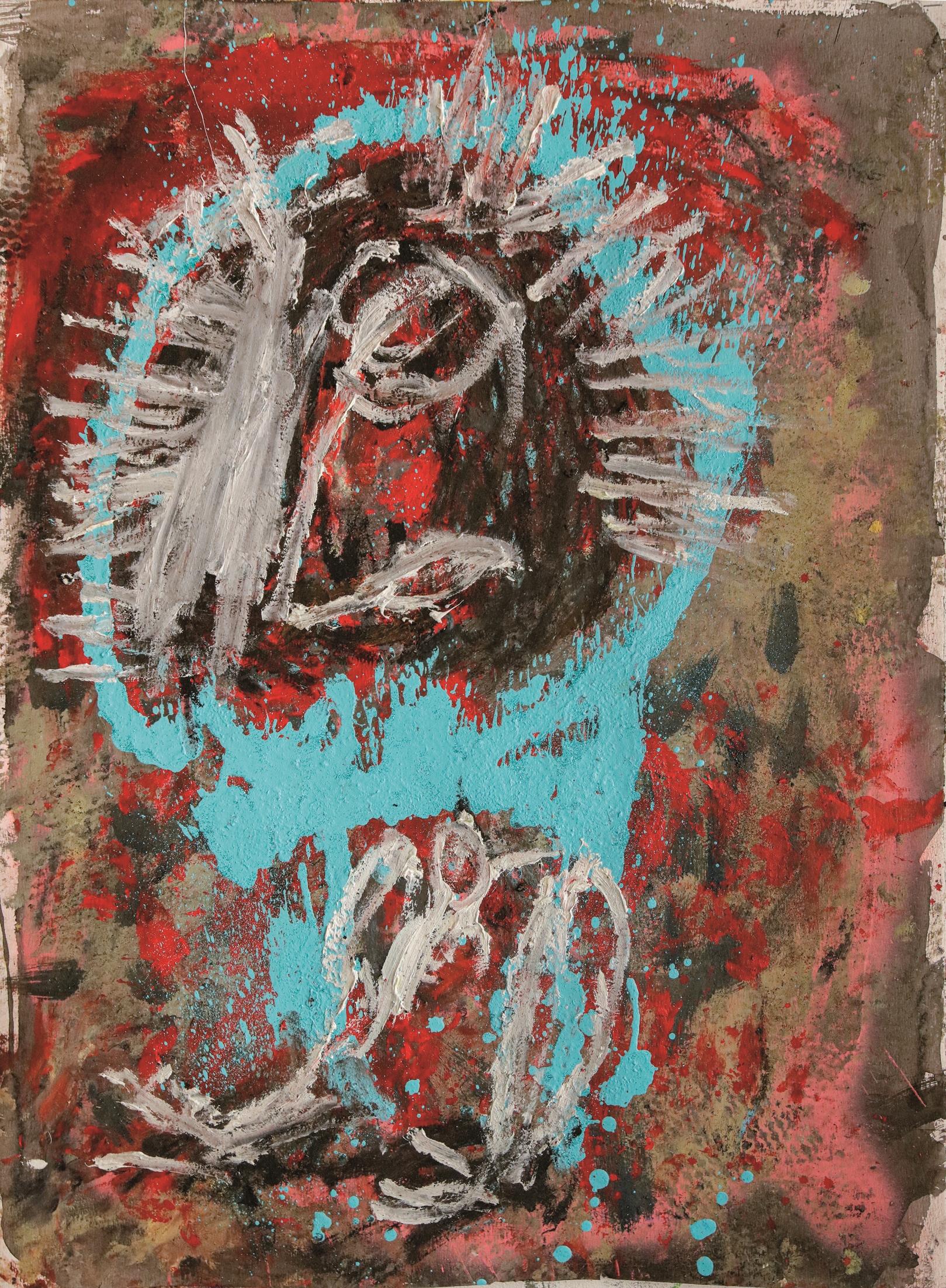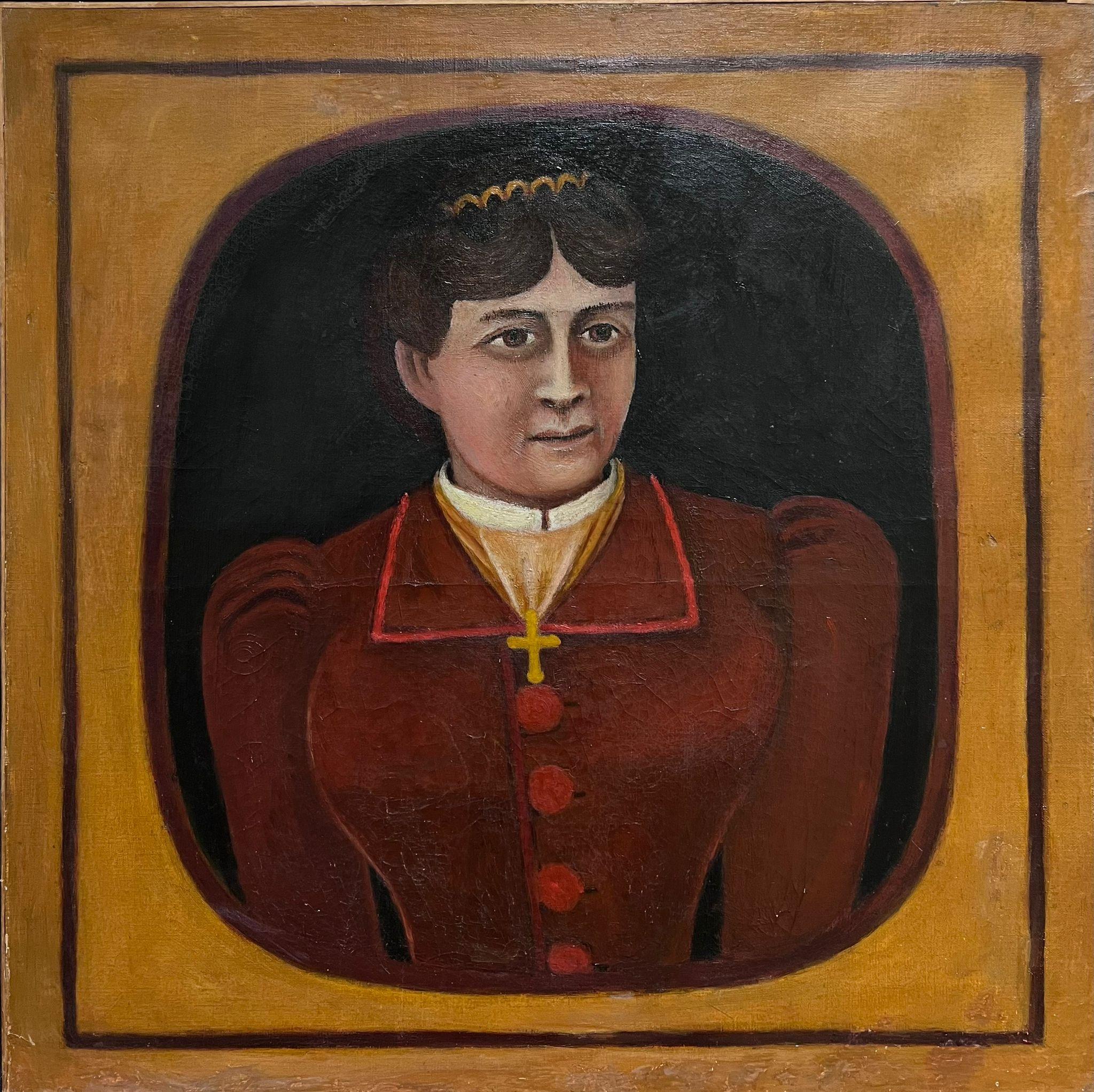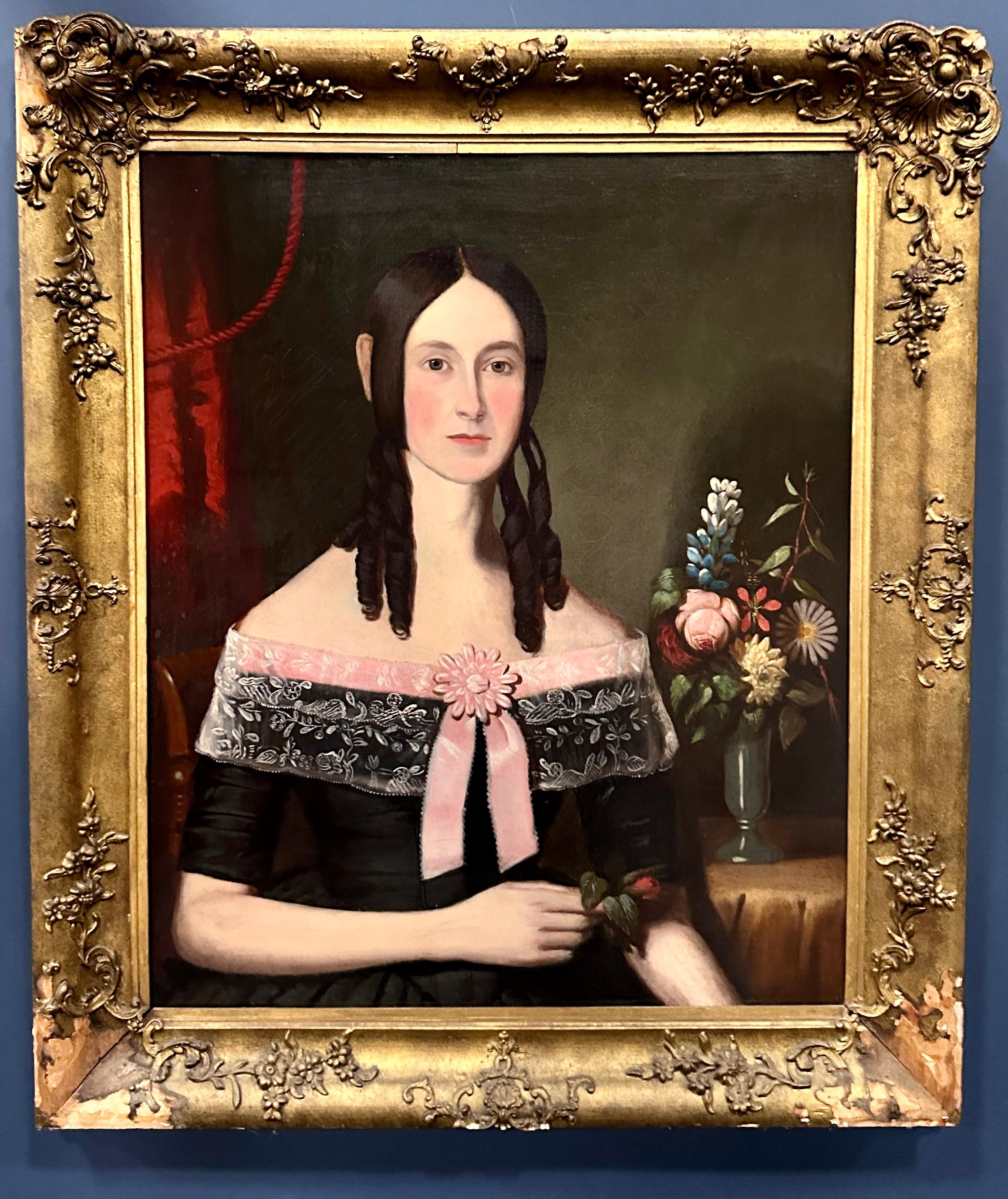Items Similar to Alabama Surreal Folk Art Oil Painting African American Woman, Flower Headdress
Want more images or videos?
Request additional images or videos from the seller
1 of 14
Alabama Surreal Folk Art Oil Painting African American Woman, Flower Headdress1960
1960
About the Item
The painting is signed Sykes and dated 1960 lower right.
It has "Maltby Sykes, 1911- for Leon" written on the stretcher verso
It is a Surrealist Folk Art figure of an African woman oil painting on canvas
Attributed to Maltby Sykes (1911-1992)
Provenance: This painting was originally purchased from the estate of Philip Bibel (San Francisco, California), received from his brother Leon Bibel. Maltby Sykes was a versatile artist. If you review Sykes's early work, you will find a lot of prints, portraits, surreal and abstract expressionist compositions. By the 1970's, Sykes style had totally changed. He was producing more non-objective, abstract work, sometimes bordering on minimalism. The surreal use of lighting, combined with representational outlines of floral abstract designs, makes this painting very interesting. I have not been able to find too many other examples of Sykes's oil painting from 1960-1965. Leon Bibel was another modernist artist, who gave this painting to his brother Phillip.
William Paul Maltby Sykes was born in Aberdeen, Mississippi in 1911, but was raised in Birmingham, Alabama.
A painter, print maker, and graphic artist, he was a long-time professor of art at the Polytechnic Institute in Auburn, Alabama, He studied at the Art Students League in New York City with John Sloan, Wayman Adams and in mexico with Diego Rivera with whom he later worked on a mural. In France on the GI bill he studied with Fernand Leger and Stanley William Hayter, and then on a subsequent trip with Andre L'hote. A Southern artist, He was a member of the Alabama Art League, Alabama Watercolor Society, and the Southeastern Art Association. Exhibition venues include many entries in Alabama, Mississippi and Louisiana as well as the Museum of Modern Art in New York, and the Pennsylvania Academy in Philadelphia. Member: Salmagundi Club. Exhibited: National Academy of Design; American Watercolor Society; Pennsylvania Academy of Fine Arts; Metropolitan Museum of Art; Modern Museum of Art.
Author: The Multi Metal Lithography Process
- Attributed to:Maltby Sykes (1911 - 1992)
- Creation Year:1960
- Dimensions:Height: 31 in (78.74 cm)Width: 24.5 in (62.23 cm)
- Medium:
- Movement & Style:
- Period:
- Condition:stretcher mark, minor wear and crazing, toning to varnish. please see photos. frame is loose.
- Gallery Location:Surfside, FL
- Reference Number:1stDibs: LU3828643022
About the Seller
4.9
Platinum Seller
These expertly vetted sellers are 1stDibs' most experienced sellers and are rated highest by our customers.
Established in 1995
1stDibs seller since 2014
1,559 sales on 1stDibs
Typical response time: 1 hour
- ShippingRetrieving quote...Ships From: Surfside, FL
- Return PolicyA return for this item may be initiated within 3 days of delivery.
More From This SellerView All
- Large Malcah Zeldis Folk Art Oil Painting Jazz Great "Satchmo" Louis ArmstrongLocated in Surfside, FLSwing Jazz Quartet. Satchmo, Louis Armstrong! Oil Painting on board. Hand signed and dated 1974 Malcah Zeldis (born Mildred Brightman; 1931) is an American folk art painter. She is ...Category
1970s Folk Art Figurative Paintings
MaterialsOil, Board
- Whimsical Judaica Shtetl Shadchan Matchmaker Oil Painting WPA Jewish Folk ArtistBy Maurice KishLocated in Surfside, FLGenre: Modern Subject: Fiddler on the roof, Shtetl matchmaker Medium: Oil Surface: Board, size includes artist decorated frame Country: United States The imagery of Maurice Kish (1895-1987), whether factories or carousels, reliably subverts expectations. His vision hovers just around the unraveling edge of things, where what is solid and clear becomes ambiguous. He is fascinated, often delighted, by the falling apart. This unexpected, fresh perspective results in oddly affecting pictures of a now long-gone New York. Born Moishe in a town called Dvinsk, Russia (what is now Daugavpils, Latvia), Kish came with his family to New York when he was in his teens. The family settled in Brownsville, and for the rest of Kish’s life Brooklyn remained his home, though he moved from one neighborhood to another. He was close to his parents, who recognized his talent and supported his desire to become an artist. Kish attended the National Academy of Design as well as Cooper Union. His fellow students included many other immigrants and children of immigrants who were particularly receptive to the Modernism coming from Europe. As his career progressed, Kish himself applied different strains of Modernism to different purposes. For him, the story was held above all else. For years, Kish used the skills he acquired in art school to earn his living at a Manhattan glass...Category
Mid-20th Century Folk Art Figurative Paintings
MaterialsBoard, Oil
- Malcah Zeldis Folk Art Gouache Painting King David Self Taught Outsider ArtistLocated in Surfside, FLMALCAH ZELDIS (American-Israeli, b. 1931), ''David and Saul'', 1982, Gouache on paper Hand signed and dated lower right, titled in pencil on paper verso...Category
1980s Folk Art Figurative Paintings
MaterialsPaper, Gouache
- Outsider Folk Art Expressionist Rabbi Israeli Painting Signed Hebrew Jewish StarLocated in Surfside, FLThis is a signed portrait painting done in an outsider, folk art, expressionist style. it is signed in Hebrew, also marked with a Jewish star. this is from a collection of works by the same hand. they are all signed. Some have markings to the back of the paper. they have some age to them. They bear similarities to artists as dissimilar as Moshe tamir, Mane Katz and an Israeli version of Purvis Young. In this piece the artist choice of colors is muted yet powerful. Israel has had a Vibrant Folk Art, Naive art scene for a long time now, artists like Yisrael Paldi, Nahum Guttman, Reuven Rubin and even Yefim Ladyzhensky had naive periods. The most well know of the strict naive artists are Shalom of Safed, Irene Awret, Gabriel Cohen, Natan Heber, Michael Falk and Kopel Gurwin. Naïve art is any form of visual art that is created by a person who lacks the formal education and training that a professional artist undergoes (in anatomy, art history, technique, perspective, ways of seeing). Unlike folk art, naïve art does not necessarily evince a distinct cultural context or tradition. Naïve art is recognized, and often imitated, for its childlike simplicity and frankness. Paintings of this kind typically have a flat rendering style with a rudimentary expression of perspective. One particularly influential painter of "naïve art" was Henri Rousseau (1844–1910), a French Post-Impressionist who was discovered by Pablo Picasso. Naïve art is often seen as outsider art that is by someone without formal (or little) training or degree. While this was true before the twentieth century, there are now academies for naïve art. Naïve art is now a fully recognized art genre, represented in art galleries worldwide. Museums devoted to naïve art now exist in Kecskemét, Hungary; Riga, Latvia; Jaen, Spain; Rio de Janeiro, Brasil; Vicq France and Paris. "Primitive art" is another term often applied to art by those without formal training, but is historically more often applied to work from certain cultures that have been judged socially or technologically "primitive" by Western academia, such as Native American, sub saharan African or Pacific Island art (see Tribal art). This is distinguished from the self-conscious, "primitive" inspired movement primitivism. Another term related to (but not completely synonymous with) naïve art is folk art. There also exist the terms "naïvism" and "primitivism" which are usually applied to professional painters working in the style of naïve art (like Paul Gauguin, Mikhail Larionov, Paul Klee). At all events, naive art can be regarded as having occupied an "official" position in the annals of twentieth-century art since - at the very latest - the publication of the Der Blaue Reiter, an almanac in 1912. Wassily Kandinsky and Franz Marc, who brought out the almanac, presented 6 reproductions of paintings by le Douanier' Rousseau (Henri Rousseau), comparing them with other pictorial examples. However, most experts agree that the year that naive art was "discovered" was 1885, when the painter Paul Signac became aware of the talents of Henri Rousseau and set about organizing exhibitions of his work in a number of prestigious galleries. The Earth Group (Grupa Zemlja) were Croatian artists, architects and intellectuals active in Zagreb from 1929 to 1935. The group included the painters Krsto Hegedušić, Edo Kovačević, Omer Mujadžić, Kamilo Ružička, Ivan Tabaković, and Oton Postružnik, the sculptors Antun Augustinčić, Frano Kršinić, and the architect Drago Ibler. Art brut, primitive art, primitive, art naïf, naïve art. Outsider art. A term applied to Yugoslav (Croatian) naive painters working in or around the village of Hlebine, near the Hungarian border, from about 1930. Some of the best known naive artists are Dragan Gaži, Ivan Generalić, Josip Generalić, Krsto Hegedušić, Mijo Kovačić, Ivan Lacković-Croata, Franjo Mraz, Ivan Večenaj and Mirko Virius. Camille Bombois (1883–1970) Ferdinand Cheval, known as 'le facteur Cheval' (1836–1924) Henry Darger (1892–1973) L. S. Lowry (1887–1976) Grandma Moses, Anna Mary Robertson (1860–1961) Nikifor (1895–1968) Poland, Horace Pippin (1888–1946) Jon Serl (1894-1993) United States Alfred Wallis (1855–1942) Scottie Wilson (1890–1972) Gesner Abelard (b. 1922) Jan Balet (1913–2009) Michel Delacroix (b. 1933) France Howard Finster (1916–2001) Ivan Rabuzin (1921–2008) Spontaneous Art Museum in Brussels Art en Marge Museum in Brussels MADmusée in Liege International Museum of Naive Art of Brazil in Cosme Velho, Rio de Janeiro Gallery Jacques Ardies in São Paulo Musée international d'art naïf de Magog in Magog Croatian Museum of Naïve Art in Zagreb Gallery of Croatian Naïve Art...Category
20th Century Outsider Art Portrait Paintings
MaterialsGouache
- Outsider Folk Art Expressionist Rabbi Israeli Painting Signed Hebrew Jewish StarLocated in Surfside, FLThis is a signed portrait painting done in an outsider, folk art, expressionist style. This one looks like a Chassidic Breslov Hasidic man. it is signed in Hebrew, also marked with a Jewish star. this is from a collection of works by the same hand. they are all signed. Some have markings to the back of the paper. they have some age to them. They bear similarities to artists as dissimilar as Moshe Tamir, Mane Katz and an Israeli version of Purvis Young. In this piece the artist choice of colors is muted yet powerful. Israel has had a Vibrant Folk Art, Naive art scene for a long time now, artists like Yisrael Paldi, Nahum Guttman, Reuven Rubin and even Yefim Ladyzhensky...Category
20th Century Outsider Art Portrait Paintings
MaterialsGouache
- Outsider Folk Art Expressionist Rabbi Israeli Painting Signed Hebrew Jewish StarLocated in Surfside, FLThis is a signed portrait painting done in an outsider, folk art, expressionist style. it is signed in Hebrew, also marked with a Jewish star. this is from a collection of works by the same hand. they are all signed. Some have markings to the back of the paper. they have some age to them. They bear similarities to artists as dissimilar as Moshe Tamir, Mane Katz and an Israeli version of Purvis Young. In this piece the artist choice of colors is muted yet powerful. Israel has had a Vibrant Folk Art, Naive art scene for a long time now, artists like Yisrael Paldi, Nahum Guttman, Reuven Rubin and even Yefim Ladyzhensky had naive periods. The most well know of the strict naive artists are Shalom of Safed, Irene Awret, Gabriel Cohen, Natan Heber, Michael Falk and Kopel Gurwin. Naïve art is any form of visual art that is created by a person who lacks the formal education and training that a professional artist undergoes (in anatomy, art history, technique, perspective, ways of seeing). Unlike folk art, naïve art does not necessarily evince a distinct cultural context or tradition. Naïve art is recognized, and often imitated, for its childlike simplicity and frankness. Paintings of this kind typically have a flat rendering style with a rudimentary expression of perspective. One particularly influential painter of "naïve art" was Henri Rousseau (1844–1910), a French Post-Impressionist who was discovered by Pablo Picasso. Naïve art is often seen as outsider art that is by someone without formal (or little) training or degree. While this was true before the twentieth century, there are now academies for naïve art. Naïve art is now a fully recognized art genre, represented in art galleries worldwide. Museums devoted to naïve art now exist in Kecskemét, Hungary; Riga, Latvia; Jaen, Spain; Rio de Janeiro, Brasil; Vicq France and Paris. "Primitive art" is another term often applied to art by those without formal training, but is historically more often applied to work from certain cultures that have been judged socially or technologically "primitive" by Western academia, such as Native American, sub saharan African or Pacific Island art (see Tribal art). This is distinguished from the self-conscious, "primitive" inspired movement primitivism. Another term related to (but not completely synonymous with) naïve art is folk art. There also exist the terms "naïvism" and "primitivism" which are usually applied to professional painters working in the style of naïve art (like Paul Gauguin, Mikhail Larionov, Paul Klee). At all events, naive art can be regarded as having occupied an "official" position in the annals of twentieth-century art since - at the very latest - the publication of the Der Blaue Reiter, an almanac in 1912. Wassily Kandinsky and Franz Marc, who brought out the almanac, presented 6 reproductions of paintings by le Douanier' Rousseau (Henri Rousseau), comparing them with other pictorial examples. However, most experts agree that the year that naive art was "discovered" was 1885, when the painter Paul Signac became aware of the talents of Henri Rousseau and set about organizing exhibitions of his work in a number of prestigious galleries. The Earth Group (Grupa Zemlja) were Croatian artists, architects and intellectuals active in Zagreb from 1929 to 1935. The group included the painters Krsto Hegedušić, Edo Kovačević, Omer Mujadžić, Kamilo Ružička, Ivan Tabaković, and Oton Postružnik, the sculptors Antun Augustinčić, Frano Kršinić, and the architect Drago Ibler. Art brut, primitive art, primitive, art naïf, naïve art. Outsider art. A term applied to Yugoslav (Croatian) naive painters working in or around the village of Hlebine, near the Hungarian border, from about 1930. Some of the best known naive artists are Dragan Gaži, Ivan Generalić, Josip Generalić, Krsto Hegedušić, Mijo Kovačić, Ivan Lacković-Croata, Franjo Mraz, Ivan Večenaj and Mirko Virius. Camille Bombois (1883–1970) Ferdinand Cheval, known as 'le facteur Cheval' (1836–1924) Henry Darger (1892–1973) L. S. Lowry (1887–1976) Grandma Moses, Anna Mary Robertson (1860–1961) Nikifor (1895–1968) Poland, Horace Pippin (1888–1946) Jon Serl (1894-1993) United States Alfred Wallis (1855–1942) Scottie Wilson (1890–1972) Gesner Abelard (b. 1922) Jan Balet (1913–2009) Michel Delacroix (b. 1933) France Howard Finster (1916–2001) Ivan Rabuzin (1921–2008) Spontaneous Art Museum in Brussels Art en Marge Museum in Brussels MADmusée in Liege International Museum of Naive Art of Brazil in Cosme Velho, Rio de Janeiro Gallery Jacques Ardies in São Paulo Musée international d'art naïf de Magog in Magog Croatian Museum of Naïve Art in Zagreb Gallery of Croatian Naïve Art...Category
20th Century Outsider Art Portrait Paintings
MaterialsGouache
You May Also Like
- Crown Jewels, colorful, figurative, outsider, narrative, three women, hatsBy Stephen BassoLocated in Brooklyn, NYOil n canvas Stephen Basso's highly original pastels and oil paintings are romantic, yet thought provoking fantasies. His whimsical works are alive with boundless imagination, wr...Category
2010s Outsider Art Portrait Paintings
MaterialsCanvas, Oil
- San Miguel, St. Michael, School of Cusco, Peru, Framed early 1900'sLocated in Houston, TXThis is painting is from the School of Cusco depicting St. Michael the Archangel defeating the devil in battle. It is oil on canvas and is in very goo...Category
Early 20th Century Folk Art Portrait Paintings
MaterialsCanvas, Oil
- Victory by abandonment Julien Wolf Contemporary art painting expressionnistBy Julien WolfLocated in Paris, FROil paint on canvas Hand-signed on the back by the artist “At first glance, we are invited to a colorful carnival. Everything is movement here! As if Julien Wolf had tried to captur...Category
2010s Outsider Art Figurative Paintings
MaterialsCanvas, Oil
- 19th Century French Naive Portrait of Lady Large Oil Painting on CanvasBy Henri RousseauLocated in Cirencester, GloucestershirePortrait of a Lady French School, 19th century circle of Henri Rousseau, French 1844 - 1910 oil on canvas, unframed canvas: 24 x 23.5 inches provenance: private collection, France co...Category
19th Century Folk Art Figurative Paintings
MaterialsOil, Canvas
- Tuscan Historical Figurative painting 20th century oil on canvasLocated in Florence, ITThe artist of this painting is unknown, but it is a direct derivation of "The Stagecoach of the Grand Duke" by Raffaello Sorbi, now held in a private collection in Milan, as we can s...Category
20th Century Folk Art Figurative Paintings
MaterialsCanvas, Oil
- 19th century American Folk Art portrait of a young lady holding a flowerLocated in Woodbury, CTVery Interesting 19th century Folk art painting of a young woman. Classic American Folk art style portrait Circa 1850-60 Oils on canvas Original frame, with a little damage. Po...Category
1850s Folk Art Portrait Paintings
MaterialsCanvas, Oil
Recently Viewed
View AllMore Ways To Browse
Vintage Flower Art
Vintage Border Art
Art By African American
Vintage African American Art
African American Art Signed
Metal Flower Art
Vintage African Painting
Vintage Oil Paintings Of Flowers
Surreal Vintage Art
New African If
Vintage Folk Art Oil Paintings
African Modern Figurative Art
African Art Metal
French Surreal
African American Woman
African American Woman Artist
The Art Of Diego Rivera
African Floral
